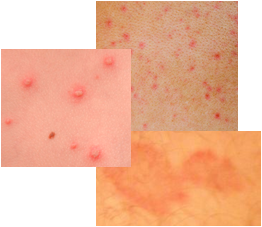Lyme Disease Rash
Visit this
PICTURES OF RASHES PAGE
Lyme Disease Cause
A bullseye or lyme disease rash on human skin is caused by a bacterium known as Borrelia Burgdorferi. This bacterium is not normally found in humans. Instead, it can be found in various animals, in particular domestic animals such as dogs and cats, but also deer and mice. So how does the bacterium end up affecting humans? The reason why humans get infected is because of ticks. Ticks bite and feed on infected animals and then can come in contact with humans. Ticks tend to live in long grass and shrubs. When a person comes in contact with this type of vegetation, the ticks attach themselves to their hosts. When they bite humans there is a chance of spreading the bacterium and subsequently lyme disease and a lyme disease rash can develop.
Lyme Disease Rash Symptoms
The rash from lyme disease, which is also known as erythema migrans, is a characteristic symptom of the early stage of lyme disease. Approximately 80 to 85 percent of people that develop lyme disease also get the skin rash. The rash, if it does appear, is easy to identify.
After three days and usually before a month after an infected tick bite, the lyme disease rash will appear. It begins at the site of the tick bite. Often there is no concern by individuals about the small red spot or in some cases several red spots that appear on the skin at the bite site. In fact, often a person has no idea that a tick has even attached itself to the skin and has bitten the skin. However, the small red spot begins to grow or spread in a circle or oval type pattern after a few days. Eventually, in many cases, the area immediately around the center of the red spot fades and the affected area of skin often takes on a ring or bull’s eye look to it. Generally, the rash area covers about a foot in diameter, but if the lyme infection progresses due to lack of treatment, a rash can appear on other skin areas away from the tick bite site. One important factor to note is that the rash may disappear in a short amount of time. Therefore, noting the characteristic lyme disease rash when it occurs is essential in diagnosing lyme disease.
The lyme disease rash can be uncomfortable or may not produce any symptoms other than redness. Other symptoms are typical of many other types of skin rashes such as burning, pain, and skin itch to various degrees.
Other Lyme Disease Symptoms
In addition to a lyme rash, early stage Lyme disease also produces some other symptoms in humans. These symptoms include: general ill feeling, headaches, fatigue and weakness, stiff neck, swollen lymph nodes, chills, muscle and joint pain, and fever. Without the presence of the characteristic skin rash, these other symptoms are very close to many other health problems and therefore diagnosis is difficult. The pictures of skin rashes page has more information.
Lyme disease can progress to a later stage due to improper treatment and the bacteria spreading in the body. Several weeks, months, or years after the initial tick bite, the later stage problems may be focussed on the nervous system. This occurs in 15 to 20 percent of infected individuals. These problems may include numbness in the arms or legs, Bell’s palsy or in other words paralysis of the facial muscles usually on one side of the face, memory loss, and difficulty concentrating.
Later stage of lyme disease may also include acute or chronic arthritis that is usually concentrated on the larger joints such as the knees. One in ten individuals may experience heart problems such as irregular heartbeats or inflammation of the lining surrounding the heart as the disease progresses.
Bulls Eye Rash Treatment
The treatment for lyme disease involves the use of antibiotics for up to one month in duration. Treatment with antibiotics is usually very successful if started in the early stages of the disease and the later stages of lyme disease will not develop. It is important to ensure that the antibiotic treatment is followed to completion. Failure to do so can result in this disease progressing to the later stages because the bacteria in the body were never completely eliminated.
Therefore, if you have had a lot of contact with animals or have been in wooded areas with long grass or bushy areas and subsequently develop the characteristic lyme disease rash, then it is possible that you have experienced a bite from a mite with the disease causing bacterium. Contact a physician whenever you suspect a mite bite or you have developed a skin rash or some of the other symptoms outlined above.
Skin rashes caused by bacteria other than Lyme disease rash:
strep | syphilis | impetigo | cellulitis | other skin rashes
